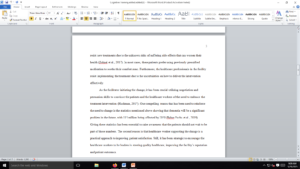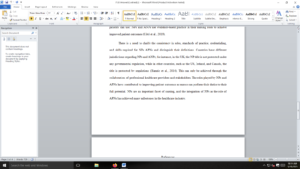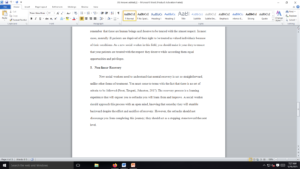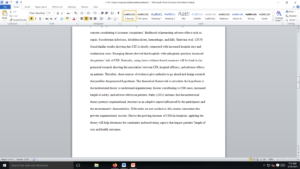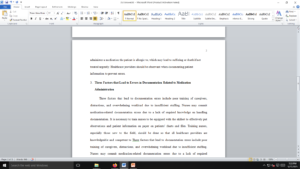Benchmark metric
Write a 4-6-page policy proposal and practice guidelines for improving quality and performance associated with the benchmark metric underperformance you advocated for improving in Assessment 1.
Evaluation of Benchmark Underperformance
Both hbA1c and low foot exam metrics have fluctuated significantly, which requires the management\’s special attention. HbA1cand low foot exams are critical in diagnosis the patients with diabetes in the early stages, thus enacting appropriate interventions. It would be hard for one to substantiate which metric is underperforming its benchmark to the highest degree. Both benchmarks are widespread in the organization, and they affect the greatest number of the patients too. The underperformance of both benchmarks has a serious impact on the patients. As Bikramjit Raveender & Sudipta (2017) outline, the hbA1c and low foot exams are important diagnostic approaches that the healthcare units utilize to diagnose diabetes. Consequently, limits the ability to diagnose and identify diabetes at an early stage before it causes serious effects on the body like organ failure. The patients are forced to live with improperly managed diabetes which turns out fatal in the future. The facility needs to implement cultural competency programs to encourage patients from minorities to seek primary health care services. It needs to train its staff on how to handle minority patients and, at the same time, respect their values and culture. Secondly, the facility needs to improve staffing and hire more primary care staff and reduce their workload.
A Recommendation for Ethical Action to Address Benchmark Underperformance
Improvement on the HbA1c and low foot exams should be Mercy Medical Center. One of the ethical recommendations that the organization needs to implement is cultural competency care and community education. The majority of the MMC clients are white people, which dissuades the minority patients from seeking healthcare services. Some of the factors that may dissuade minority patients from seeking primary healthcare services are language barriers, cultural values, and norms differences, among others (Lopes Campelo et al.,2018). The facility should train its health staff on how to handle and treat minority patients. It needs to train them to understand and respect the diverse cultures and use this knowledge to offer patient-centered care. Secondly, the facility needs to improve staffing to reduce work overload on the existing staff. Poor performance in the primary care unit is a consequence of numerous inadequate staffing (Glette, Aase, & Wiig, 2017). Improving the number of staff will increase the hbA1c and low foot exams, thus improving diabetes management in the Shakopee community and the entire country too.
The policy proposal requirements outlined below correspond to the scoring guide criteria, so be sure to address each main point. Read the performance-level descriptions for each criterion to see how your work will be assessed. In addition, be sure to note the requirements for document format and length and for supporting evidence.
- Explain the need for creating a policy and practice guidelines to address a shortfall in meeting a benchmark metric prescribed by local, state, or federal health care policies or laws.
- Recommend ethical, evidence-based practice guidelines to improve targeted benchmark performance prescribed by applicable local, state, or federal health care policy or law.
- Analyze the potential effects of environmental factors on your recommended practice guidelines.
- Explain why particular stakeholders and groups must be involved in further development and implementation of your proposed policy and practice guidelines.
- Organize content so ideas flow logically with smooth transitions.
- Use paraphrasing and summarization to represent ideas from external sources.
Example Assessment: You may use the following to give you an idea of what a Proficient or higher rating on the scoring guide would look like:
Policy Proposal Format and Length
It may be helpful to use a template or format for your proposal that is used in your current organization. The risk management or quality department could be a good resource for finding an appropriate template or format. If you are not currently in practice, or your organization does not have these resources, many appropriate templates are freely available on the Internet.
Your policy should be succinct (about one paragraph). Overall, your proposal should be 4–6 pages in length.
Supporting Evidence
Cite 3–5 references to relevant research, case studies, or best practices to support your analysis and recommendations.
Competencies Measured
By successfully completing this assessment, you will demonstrate your proficiency in the course competencies through the following assessment scoring guide criteria:
- Competency 1: Analyze relevant health care laws, policies, and regulations; their application; and their effects on organizations, interprofessional teams, and professional practice.
- Competency 2: Lead the development and implementation of ethical and culturally sensitive policies that improve health outcomes for individuals, organizations, and populations.
- Competency 3: Evaluate relevant indicators of performance, such as benchmarks, research, and best practices, to inform health care laws and policies for patients, organizations, and populations.
- Competency 4: Develop strategies to work collaboratively with policy makers, stakeholders, and colleagues to address environmental (governmental and regulatory) forces.
- Competency 5: Produce clear, coherent, and professional written work, in accordance with Capella\’s writing standards.
Answer preview
International Diabetes Federation and the World Healthcare Organizations (WHO) recommend efforts to reduce amputations by 50% through a comprehensive intervention that incorporates prevention, multidisciplinary treatment, patient and staff education, and close monitoring (Bus et al., 2020). Efforts to prevent DPN are the basic principle that informs practical guidelines in care for diabetes. American Association of Diabetic Educators emphasizes that the most effective approach to care is in response to each patient’s unique needs (AADE, 2020).
[2029 Words]
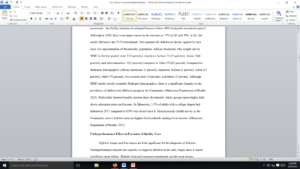
Benchmark metric


